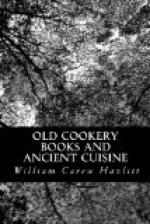Metheglin and beer of some kind appear to be the most ancient liquors of which there are any vestiges among the Britons. Ferguson, in his Essay “On the Formation of the Palate,” states that they are described by a Greek traveller, who visited the south of Britain in the fourth century B.C. This informant describes metheglin as composed of wheat and honey (of course mixed with water), and the beer as being of sufficient strength to injure the nerves and cause head-ache.
Worlidge, in his “Vinetum Britannicum,” 1676, gives us receipts for metheglin and birch wine. Breton, in his “Fantasticks,” 1626, under January, recommends a draught of ale and wormwood wine mixed in a morning to comfort the heart, scour the maw, and fulfil other beneficial offices.
The English beer of by-gone times underwent many vicissitudes, and it was long before our ancestors conquered their dislike to the bitter hop, after having been accustomed to a thick, sweet liquor of which the modern Kentish ale is in some measure a survival. Beer was made from a variety of grain; oats were most commonly employed. In France, they resorted even to vetches, lentils, rye, and darnel. But as a rule it was a poor, thin drink which resulted from the operation, and the monks of Glastonbury deemed themselves fortunate in being allowed by their abbot to put a load of oats into the vat to improve the quality of the beverage; which may account for Peter of Blois characterising the ale in use at Court in his day (he died about the end of the twelfth century) as potent—it was by contrast so. The first assize of ale seems not to have been enacted till the reign of Henry III.
From a glossary of the fourteenth century, inserted in “Reliquse Antique,” 1841, it appears that whey was then used as a drink; it occurs there as “cerum, i, quidam liquor, whey.”
THE KITCHEN.
In direct connection with cookery as with horticulture, are the utensils and appliances which were at the command of those who had to do with these matters in days of yore; and in both cases an inquirer finds that he has to turn from the vain search for actual specimens belonging to remoter antiquity to casual representations or descriptions in MSS. and printed books. Our own museums appear to be very weakly furnished with examples of the vessels and implements in common use for culinary purposes in ancient times, and, judging from the comparatively limited information which we get upon this subject from the pages of Lacroix, the paucity of material is not confined to ourselves. The destruction and disappearance of such humble monuments of the civilisation of the past are easily explained; and the survival of a slender salvage is to be treated as a circumstance not less remarkable than fortunate.
It seems that the practice was to cut up, if not to slaughter, the animals used for food in the kitchen, and to prepare the whole carcase, some parts in one way and some in another. We incidentally collect from an ancient tale that the hearts of swine were much prized as dainties.




